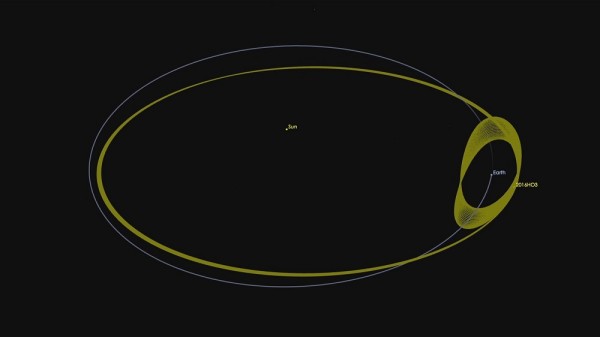Earth Has Two Moons? Nope, Just a Small Asteroid 'Quasi-Satellite' Orbiting Earth
| Ana Verayo | | Jun 17, 2016 05:29 AM EDT |
(Photo : NASA/JPL-Caltech ) Asteroid 2016 HO3 has an orbit around the sun that keeps it as a constant companion of Earth.
Earth apparently has a new cosmic object companion, as a new asteroid was detected that orbits around the Sun and also follows the orbit of Earth, where astronomers believe that this will continue to do so for hundreds of years more.
This new asteroid known as 2016 HO3 is now circling around Earth, however it might be too distant to be considered as a true, natural satellite of the planet, as scientists dub this as a "quasi satellite".
Like Us on Facebook
According to NASA's Center for Near-Earth Object (NEO) and Jet Propulsion Laboratory's Paul Chodas, this asteroid is now looping around our planet, however, it also does not venture very far away, as both the Earth and this quasi satellite orbits around the sun.
New findings also reveal that 2016 HO3 has already been a stable quasi satellite of Earth for more than a hundred years now, in which it will continue to do so in this pattern for centuries.
During half of the time asteroid 2016 HO3 orbits around the sun, it is also half as close compared to the distance of Earth from the sun and half of the time, it is also half as farther away from Earth's distance from the sun. It also possesses an odd orbit, that is tilting a bit, making it bob up and down each year Earth's gravity affects its orbit.
Over the decades, this asteroid also experiences a twisted back and forth orbit. Chodas describes this orbit as looping a little bit ahead and behind from Earth's orbit every year, however, the gravitational forces of Earth is powerful enough to reverse this drift that the asteroid does not stray away from more than 100 times the distance of the moon, resulting in a "little dance" with our planet.
This asteroid is estimated to measure more than 120 feet but less than 300 feet in diameter. This was also first detected just last April by the Pan-STARRS 1 asteroid survey in Haleakala, Hawaii, in the Institute for Astronomy of Hawaii.
Tagsearth two moons, earth constant companion, earth small asteroid, asteroids, quasi satellite, NASA JPL, NASA NEO
©2015 Chinatopix All rights reserved. Do not reproduce without permission
EDITOR'S PICKS
-

Did the Trump administration just announce plans for a trade war with ‘hostile’ China and Russia?
-

US Senate passes Taiwan travel bill slammed by China
-

As Yan Sihong’s family grieves, here are other Chinese students who went missing abroad. Some have never been found
-

Beijing blasts Western critics who ‘smear China’ with the term sharp power
-

China Envoy Seeks to Defuse Tensions With U.S. as a Trade War Brews
-

Singapore's Deputy PM Provides Bitcoin Vote of Confidence Amid China's Blanket Bans
-

China warns investors over risks in overseas virtual currency trading
-

Chinese government most trustworthy: survey
-

Kashima Antlers On Course For Back-To-Back Titles
MOST POPULAR
LATEST NEWS
Zhou Yongkang: China's Former Security Chief Sentenced to Life in Prison

China's former Chief of the Ministry of Public Security, Zhou Yongkang, has been given a life sentence after he was found guilty of abusing his office, bribery and deliberately ... Full Article
TRENDING STORY

China Pork Prices Expected to Stabilize As The Supplies Recover

Elephone P9000 Smartphone is now on Sale on Amazon India

There's a Big Chance Cliffhangers Won't Still Be Resolved When Grey's Anatomy Season 13 Returns

Supreme Court Ruled on Samsung vs Apple Dispute for Patent Infringement

Microsoft Surface Pro 5 Rumors and Release Date: What is the Latest?










